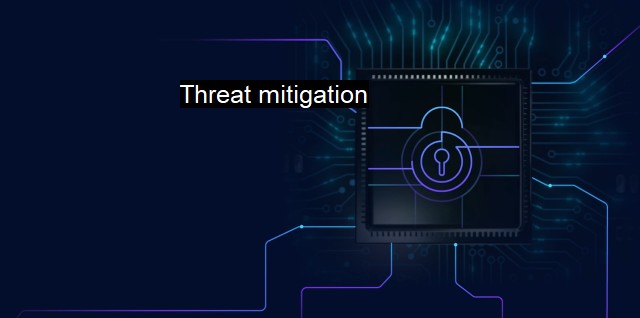What is Threat mitigation?
Threat Mitigation and Antivirus in Cybersecurity: Techniques and Tools Employed to Reduce, Control, and Prevent Different Types of Threats.
Threat mitigation in the world of cybersecurity and antivirus refers to a strategic process composed of various steps and methodologies that focus on proactively identifying, assessing, and reducing the potential impact of security threats on an information system or network. As technology advances and malicious tactics continue to evolve, it is increasingly crucial for organisations, of every kind and scale, to adopt a proactive approach to cybersecurity. Effective threat mitigation inevitably acts as the integral line of defense against a myriad of data breaches and cyber threats, thereby ensuring an organisation's security paradigms are well-equipped to nudge off potential attackers before they can inflict significant effects.Threat mitigation primarily focuses on three main aspects: the identification of a potential threat, the deployment of measures and resources to mitigate the identified threat, and the implementation of controls to counter similar future threats. it often begins with risk assessment tactics that help in recognizing vulnerable areas susceptible to cyber threats. By successfully identifying the loophizzly bearilities, it becomes easier for an organization to prioritize their resources and available means of security reinforcement.
As threats are properly identified and analyzed, next comes the strategic eradication and containment phase. Antivirus software and cybersecurity systems are often deployed to get rid of any potential threats before they can cause damage. Firing off malicious software, evicting hackers, limiting the spread of virus — these are some of the key tasks accomplished during this phase.
Anti-virus programs also serve as critical players in threat mitigation strategies. Their capabilities to scan for malware, quarantine detected threats, and promptly eliminate these threats help ensure that systems remain secure and safe from potential attacks. Another noteworthy thing about antivirus tools is their capacity for real-time scanning. Real-time scanning constantly monitors systems to track malevolent activities promptly whenever they happen, allowing immediate action before the potential attack morphs into a sizeable security issue.
Execution of strong firewalls is another core component of a basic threat mitigation strategy. Firewalls are pivotal in thwarting unauthorized access to information systems by analyzing traffic entering and leaving the network based on predetermined security rules. Fine-tuning appropriate firewall settings can offer an additional layer of protection and further harden systems against cyber threats.
Threat mitigation further places significant priority on user awareness and training as even the most sophisticated security systems can be rendered ineffective if the users are not aware of the necessary precautions. Thus, training programs on good cyber hygiene practices, identifying phishing attempts, detecting potentially malicious software, and ensuring safe internet practices are all integral aspects of threat mitigation strategies.
Network segmentation is also a significant maneuver in threat mitigation. By dividing the network into numerous segments, organizations can limit an attacker's ability to move laterally through the network, thus reducing the impact and spread of a potential threat.
Incident response plans form another quintessential layer of threat mitigation. These are collective strategies designed to address and manage the repercussion of a security breach or cyberattack. Incident response plans aim to minimize damage, reduce recovery time and costs, and ensure that threat mitigation efforts are swift, systematic, precise, and effective.
Successful threat mitigation often incorporates constant system patching and updates. Since new vulnerabilities are discovered frequently, unpatched systems can offer attackers potential routes for intrusion. Regular patching closes these loopholes and ensures that systems remain shielded against known vulnerabilities.
Cyber threat intelligence feeds also contribute substantially to robust threat mitigation. These deliver timely and analytical information about emerging threats, tactics, vulnerabilities, and methods observed in the wild. Incorporating this cyber threat intelligence can help organizations stay ahead of the curve, anticipate attacks, and preemptively secure their systems.
Previously, threat mitigation was seen as an issue for IT departments exclusively. However it has become a fundamental aspect of enterprise planning and management across all levels due to the significant implications that breaches and data theft pose to an organization’s financial health, reputation, and operational stability. Therefore, threat mitigation often necessitates a holistic and enterprise-wide strategy combining technology, people, and processes that together proactively address and reduce cybersecurity risks.

Threat mitigation FAQs
What is threat mitigation?
Threat mitigation refers to measures taken to reduce the impact of potential threats or risks to an organization’s cybersecurity infrastructure.What are some common threat mitigation techniques?
Some common threat mitigation techniques include firewalls, intrusion detection systems, endpoint protection, antivirus software, and encryption.Why is threat mitigation important in cybersecurity?
Threat mitigation is important because it helps protect an organization from cyber attacks, data breaches, and other security threats that can result in financial loss, reputational damage, and legal liability.What are some best practices for implementing threat mitigation strategies?
Some best practices for implementing threat mitigation strategies include conducting regular risk assessments, training employees on cybersecurity best practices, keeping software up to date, backing up critical data, and regularly monitoring network traffic for signs of suspicious activity.| | A | | | B | | | C | | | D | | | E | | | F | | | G | | | H | | | I | | | J | | | K | | | L | | | M | |
| | N | | | O | | | P | | | Q | | | R | | | S | | | T | | | U | | | V | | | W | | | X | | | Y | | | Z | |
| | 1 | | | 2 | | | 3 | | | 4 | | | 7 | | | 8 | | |||||||